Title
MICHELANGELO PISTOLETTO One and One makes ThreePosted In
Installation, Sculpture, ExhibitionArtist
Michelangelo PistolettoDuration
10 May 2017 to 26 November 2017Venue
Basilica di San Giorgio, Isola di San Giorgio Maggiore, VeniceOpening Hours
Tuesday to Saturday: 10:00 – 18:00 / Sunday: 14:00 – 18:00| Detailed Information | |||||
|---|---|---|---|---|---|
| Title | MICHELANGELO PISTOLETTO One and One makes Three | Posted In | Installation, Sculpture, Exhibition | Artist | Michelangelo Pistoletto |
| Duration | 10 May 2017 to 26 November 2017 | Venue | Basilica di San Giorgio, Isola di San Giorgio Maggiore, Venice | Opening Hours | Tuesday to Saturday: 10:00 – 18:00 / Sunday: 14:00 – 18:00 |
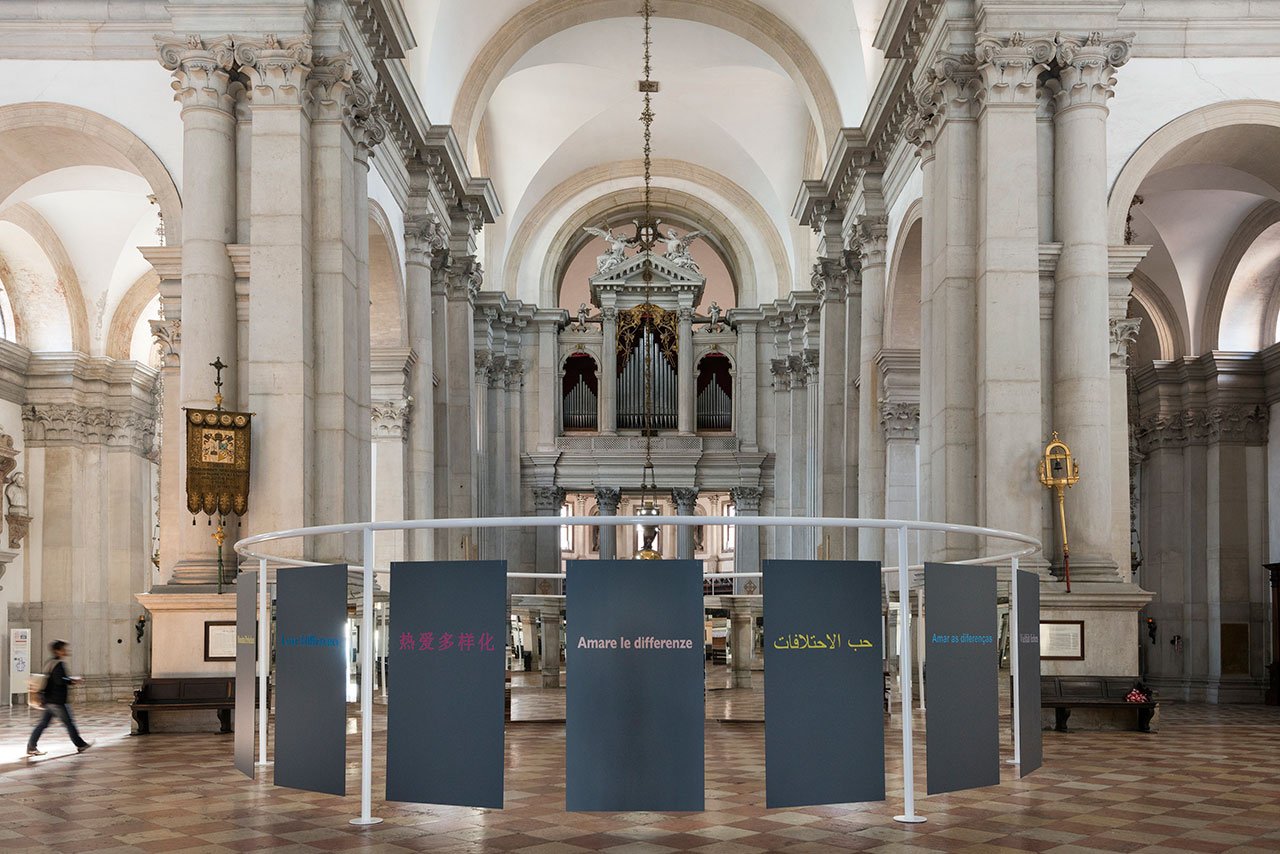
Michelangelo Pistoletto “One and One makes Three” at Basilica di San Giorgio, Isola di San Giorgio Maggiore, Venice Biennale, 2017. Courtesy the artist and GALLERIA CONTINUA, San Gimignano / Beijing / Les Moulins / Habana. Photo by Oak Taylor-Smith.
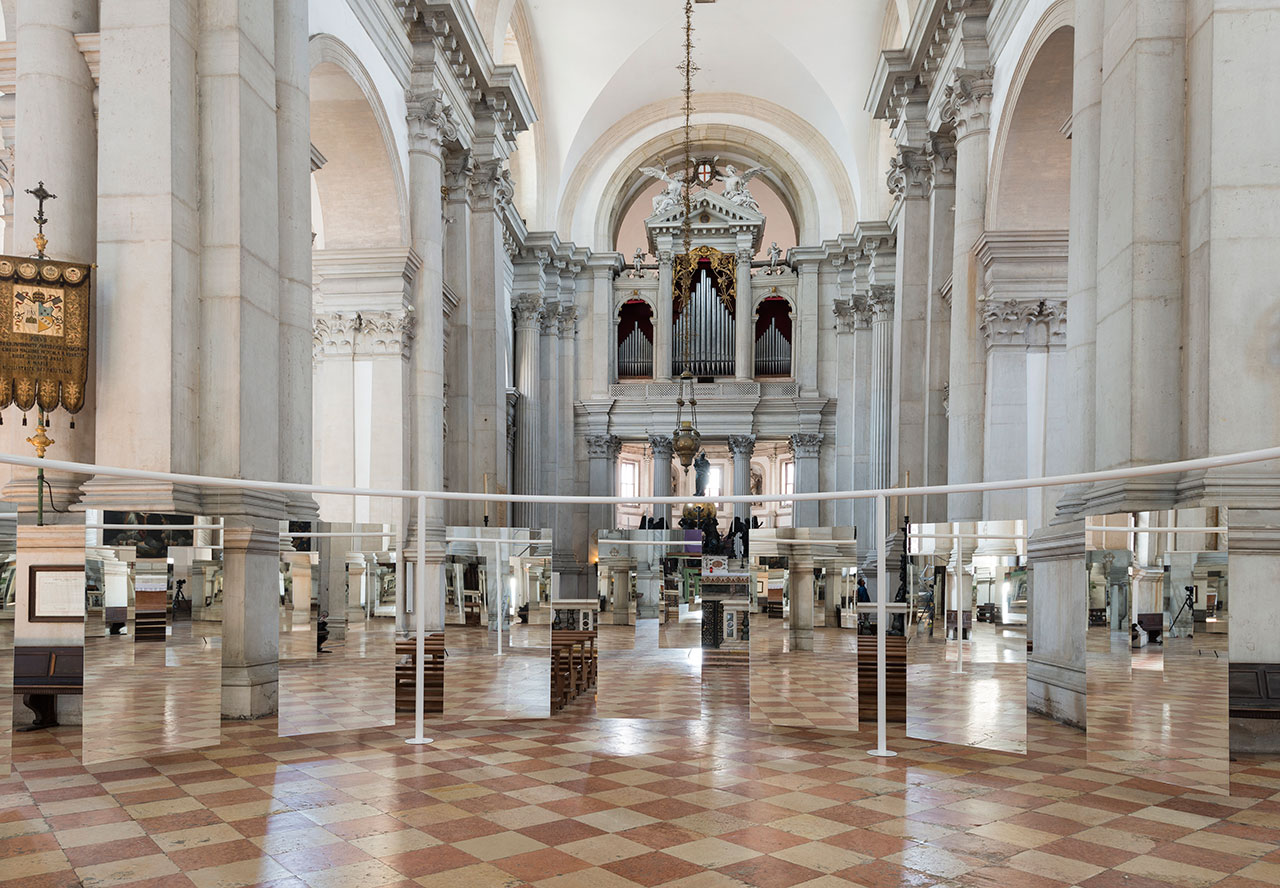
Michelangelo Pistoletto “One and One makes Three” at Basilica di San Giorgio, Isola di San Giorgio Maggiore, Venice Biennale, 2017. Courtesy the artist and GALLERIA CONTINUA, San Gimignano / Beijing / Les Moulins / Habana. Photo by Oak Taylor-Smith.
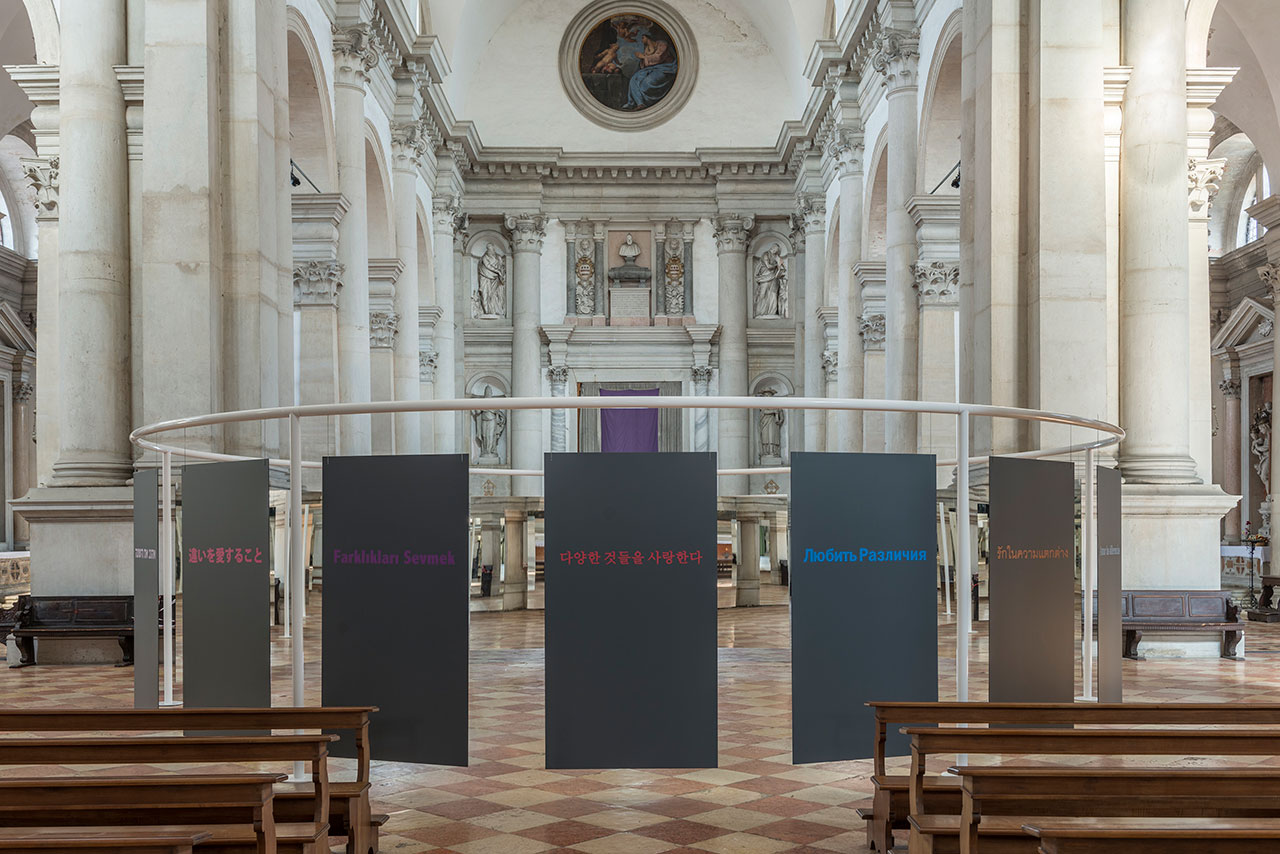
Michelangelo Pistoletto “One and One makes Three” at Basilica di San Giorgio, Isola di San Giorgio Maggiore, Venice Biennale, 2017. Courtesy the artist and GALLERIA CONTINUA, San Gimignano / Beijing / Les Moulins / Habana. Photo by Oak Taylor-Smith.
These works marked a career-long love affair with mirrors in terms of output, paintings, sculptures and installations, and theoretical reflection. For Pistoletto, mirrors constitute an image of the world, both of people and society, and of cosmic space, making these works a “self-portrait of the world”—a fitting description considering that the idea arose while he was creating a series of self-portraits, also on display in the show, which demanded the use of a mirror.
His most recent “Mirror Paintings”, also on view at the exhibition, pay tribute to the culture and people of Cuba. Inspired during a visit on the island in 2015 and its precarious transition from communism to capitalism, the works capture everyday scenes on the streets of Havana, wherein the viewer, courtesy of the mirrored background, is suddenly transposed to.
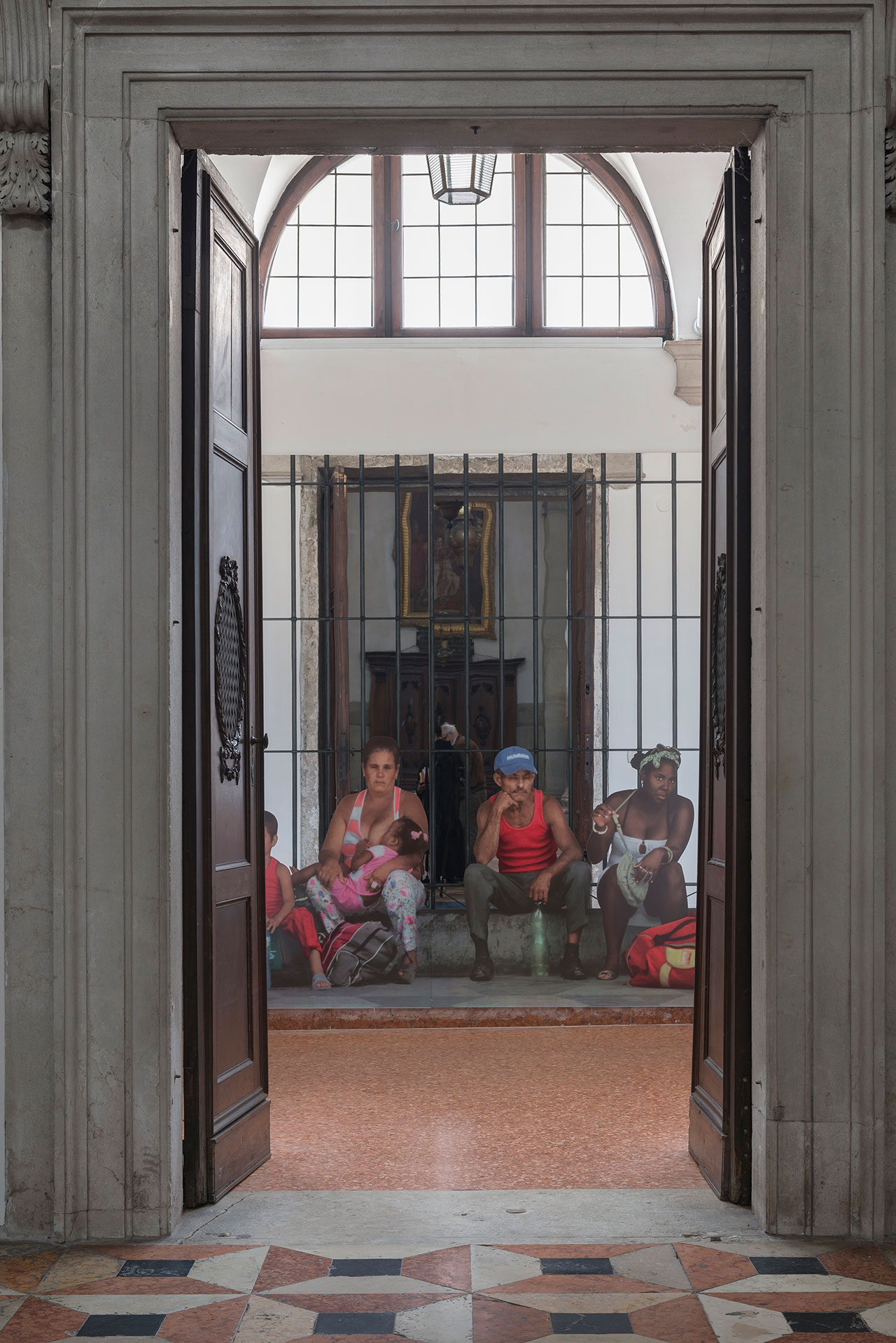
Michelangelo Pistoletto “One and One makes Three” at Basilica di San Giorgio, Isola di San Giorgio Maggiore, Venice Biennale, 2017. Courtesy the artist and GALLERIA CONTINUA, San Gimignano / Beijing / Les Moulins / Habana. Photo by Oak Taylor-Smith.
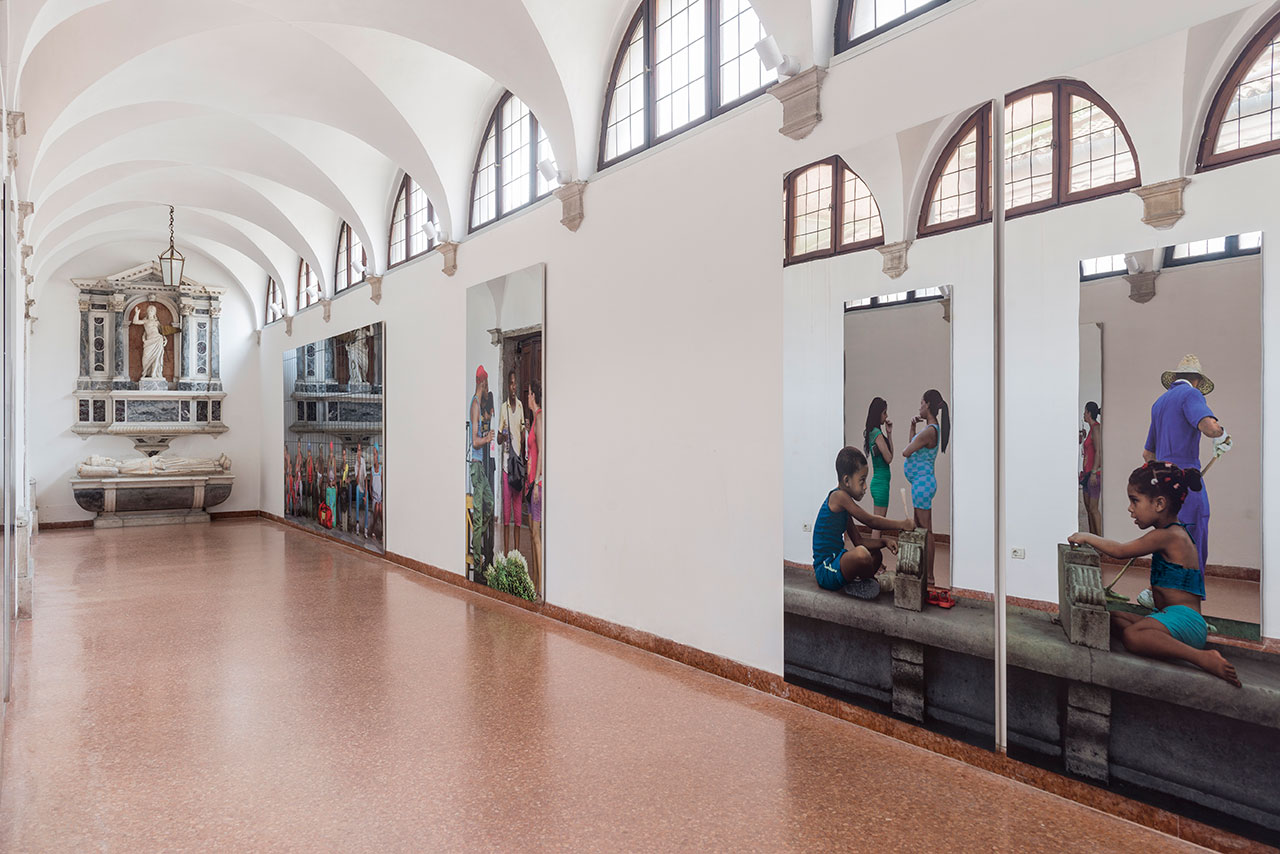
Michelangelo Pistoletto “One and One makes Three” at Basilica di San Giorgio, Isola di San Giorgio Maggiore, Venice Biennale, 2017. Courtesy the artist and GALLERIA CONTINUA, San Gimignano / Beijing / Les Moulins / Habana. Photo by Oak Taylor-Smith.
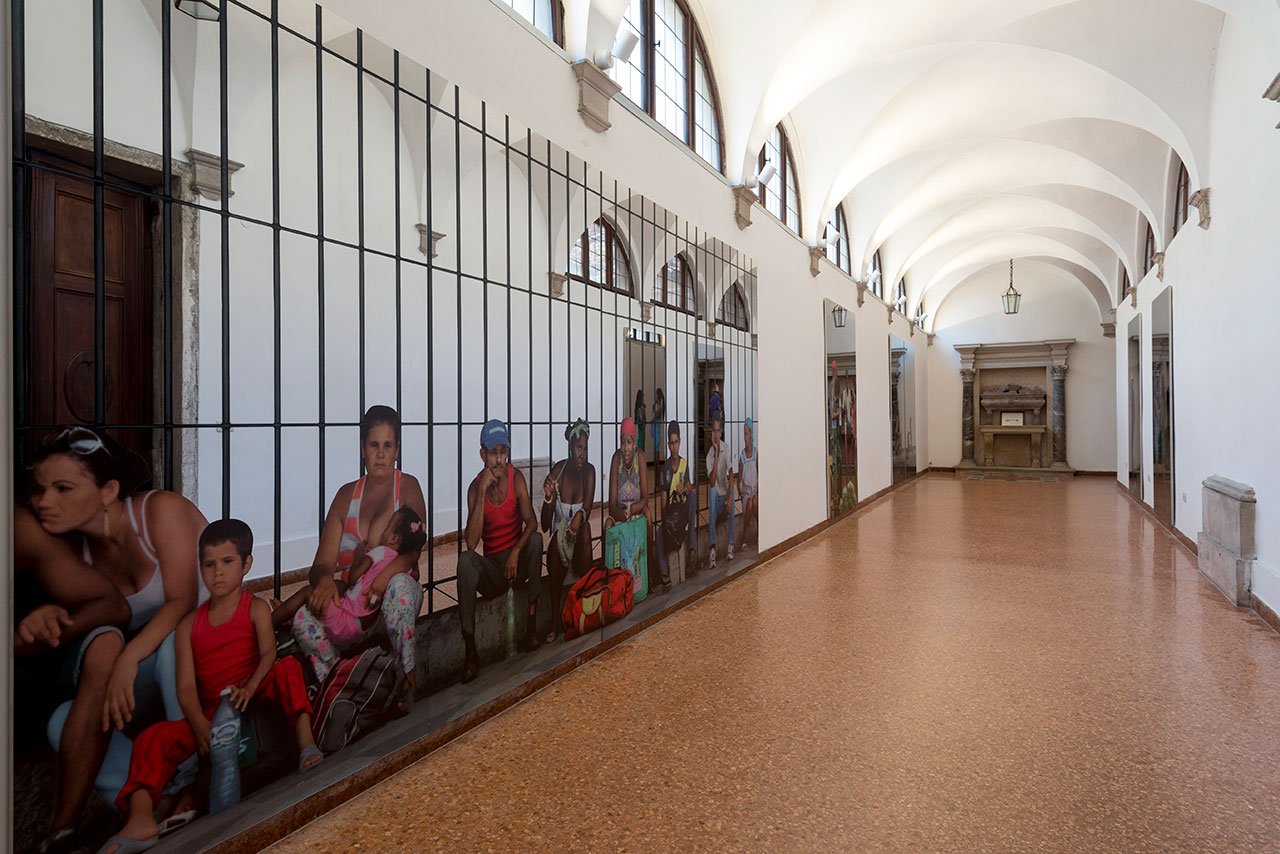
Michelangelo Pistoletto “One and One makes Three” at Basilica di San Giorgio, Isola di San Giorgio Maggiore, Venice Biennale, 2017. Courtesy the artist and GALLERIA CONTINUA, San Gimignano / Beijing / Les Moulins / Habana. Photo by Oak Taylor-Smith.
The exhibition also includes a selection of Pistoletto’s “Minus Objects”, a series of non-representational works conceived in 1965 as an investigation into how objects can be transformed into artworks through the ideas they express. Constructed out of ‘poor’ materials and defying the dogma that every artist’s work should be stylistically recognizable, these works were an act of independence against the prevailing art system as well as a precursor of the Arte Povera movement. Works from the series on display include “Bagno” (1965-1966), a resin bathtub, “Vetrina” (1965-1966), a display case showcasing a painter’s soiled overalls, and “Semisfere Decorative” (1965-1966), a geometric painting created out of plastic beads.
Stealing the show among Pistoletto's “Minus Objects” is “Venus of the Rags” (1967), one of the most representative works of Arte Povera that features an enameled cement replica of the Thorvaldsen statue of Venus placed among a mound of rags. Pitting the beauty of classical art against the accumulation of waste, the work is a nexus of contradictions—hard/soft, formed/unformed, monochrome/coloured, precious/disregarded, historical/contemporary etc—whereby the language of Pop Art is co-opted to comment on the cycle of consumption. Fittingly, Pistoletto made several versions of this work.
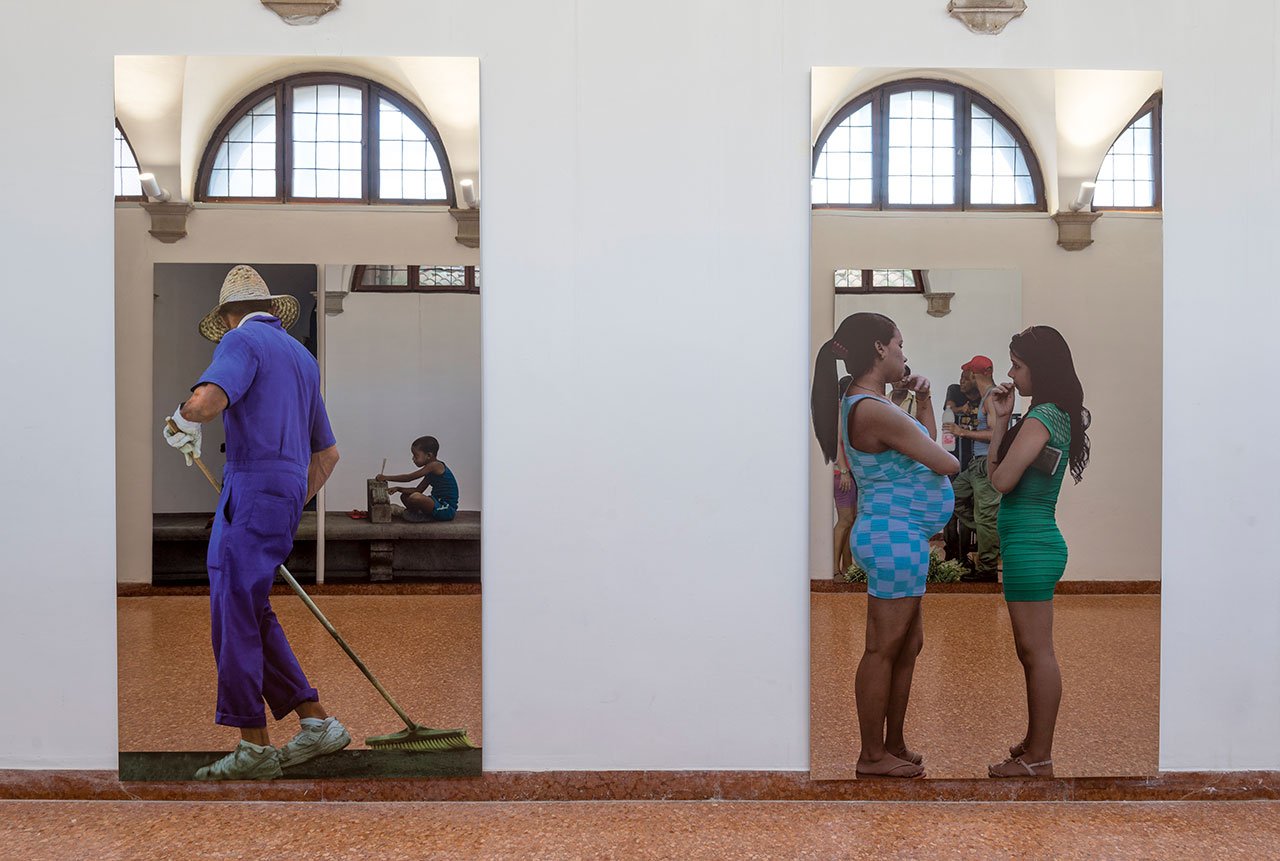
Michelangelo Pistoletto “One and One makes Three” at Basilica di San Giorgio, Isola di San Giorgio Maggiore, Venice Biennale, 2017. Courtesy the artist and GALLERIA CONTINUA, San Gimignano / Beijing / Les Moulins / Habana. Photo by Oak Taylor-Smith.
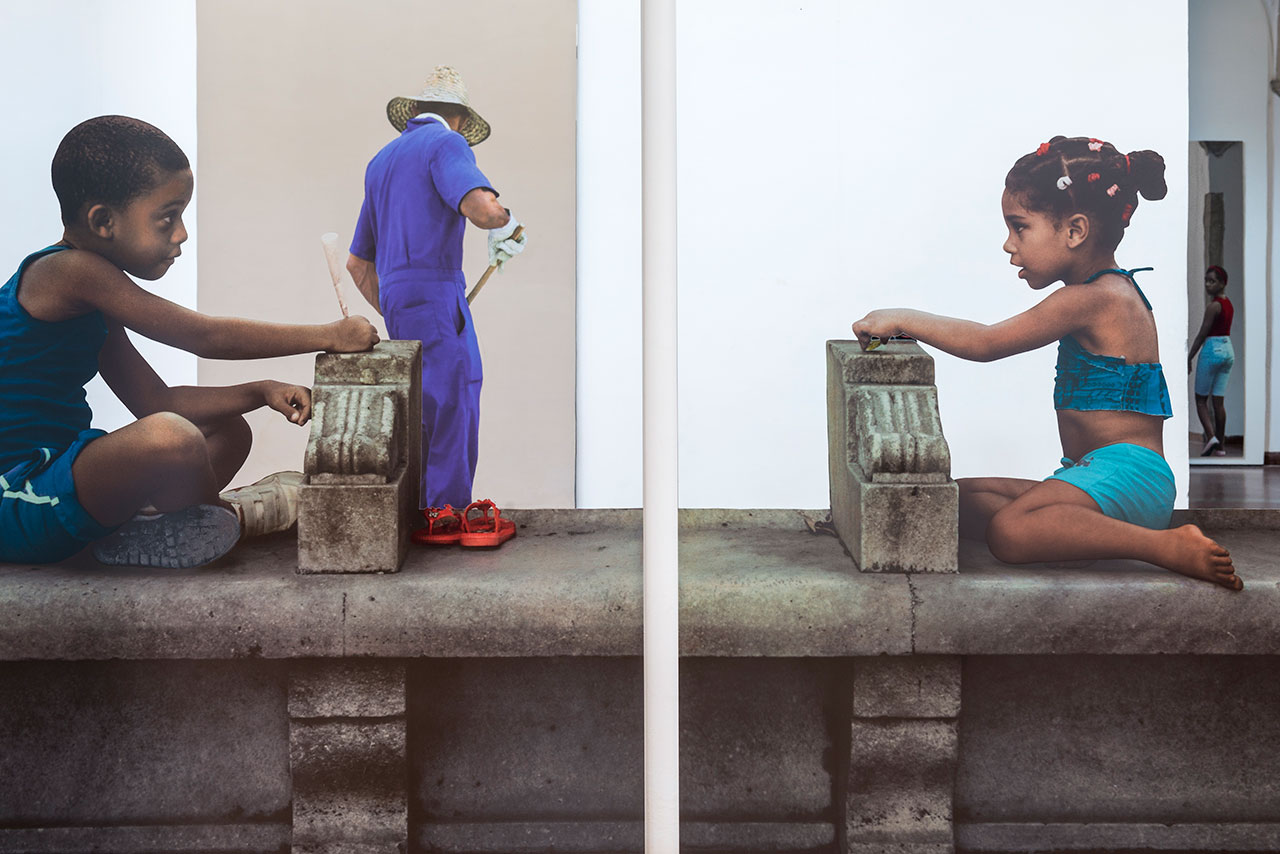
Michelangelo Pistoletto “One and One makes Three” at Basilica di San Giorgio, Isola di San Giorgio Maggiore, Venice Biennale, 2017. Courtesy the artist and GALLERIA CONTINUA, San Gimignano / Beijing / Les Moulins / Habana. Photo by Oak Taylor-Smith.
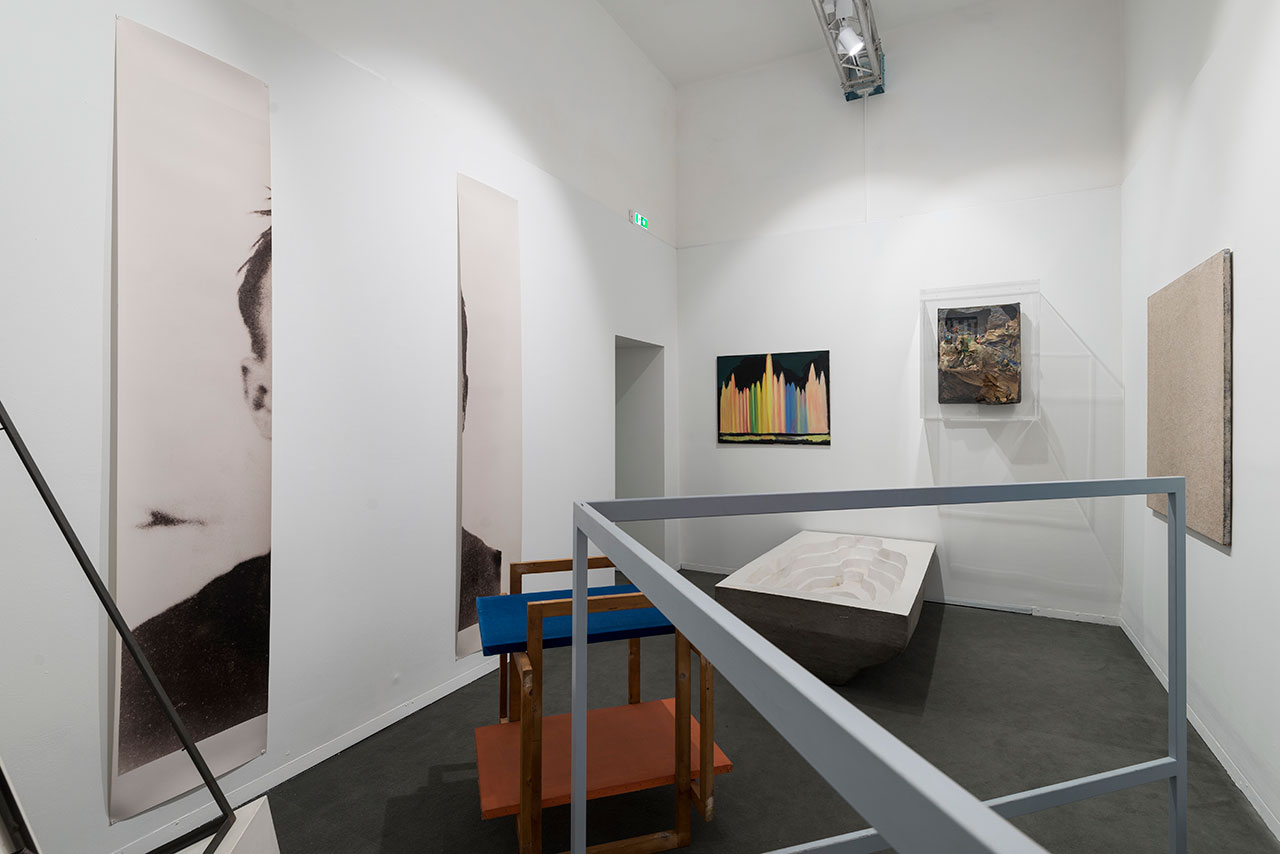
Michelangelo Pistoletto “One and One makes Three” at Basilica di San Giorgio, Isola di San Giorgio Maggiore, Venice Biennale, 2017. Courtesy the artist and GALLERIA CONTINUA, San Gimignano / Beijing / Les Moulins / Habana. Photo by Oak Taylor-Smith.
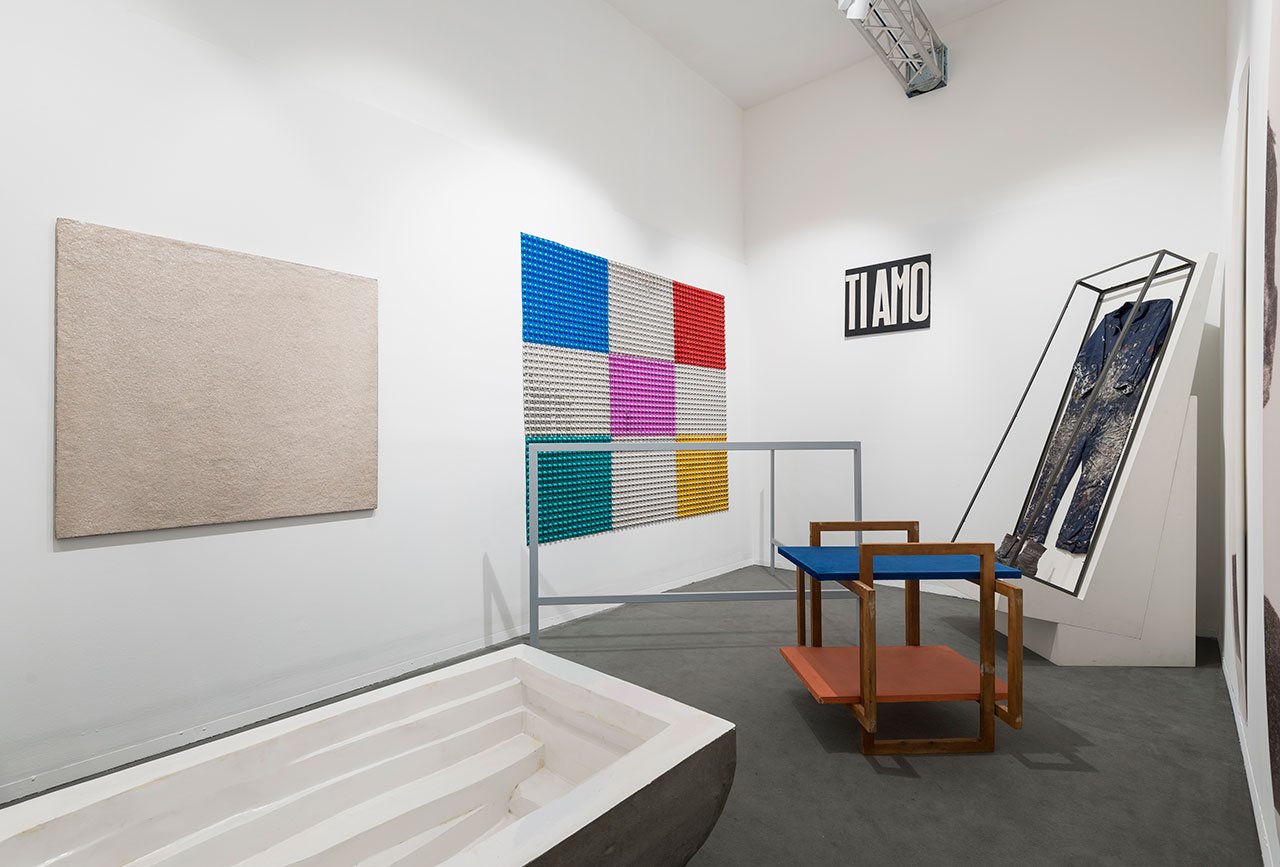
Michelangelo Pistoletto “One and One makes Three” at Basilica di San Giorgio, Isola di San Giorgio Maggiore, Venice Biennale, 2017. Courtesy the artist and GALLERIA CONTINUA, San Gimignano / Beijing / Les Moulins / Habana. Photo by Oak Taylor-Smith.
Taking center stage, both literally and conceptually, is “Suspended Perimeter – Love Difference” (1975–2011), a performative mirror installation made out of suspended mirrors that form a circular space of meditation and connectivity in the middle of the basilica of San Giorgio. This alternative ‘altar’ is an exponent of the artist’s 2002 “Love Difference Manifesto”, which established an artistic movement aiming to bring together the people and cultures of the Mediterranean—represented in the different languages inscribed on the back of the panels—a region that mirrors the problems and conflicts of global society. For Pistoletto, in order to find our humanity we have to move beyond the rational notion of tolerance by accepting and embracing the differences between people and social groups, as exemplified by the installation’s new inhabited spatial possibilities.
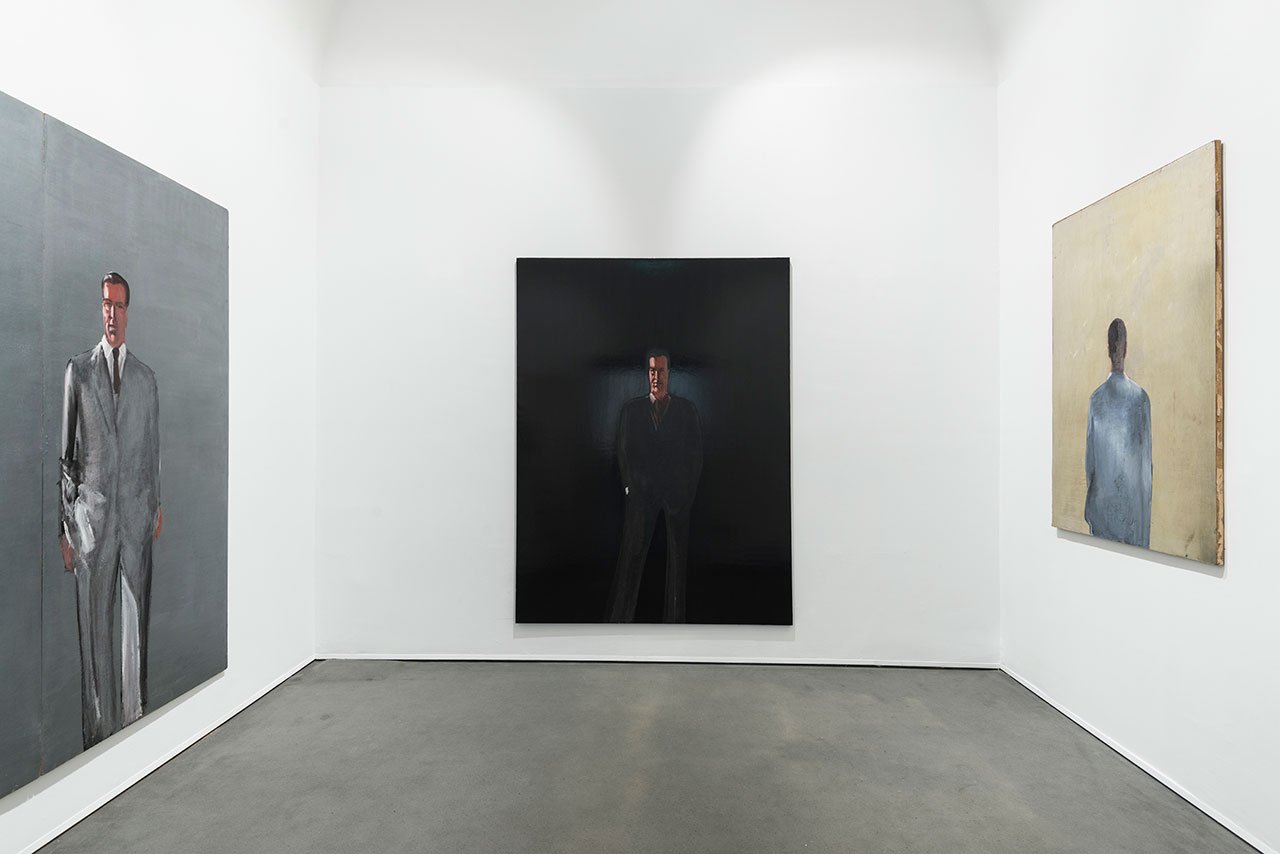
Michelangelo Pistoletto “One and One makes Three” at Basilica di San Giorgio, Isola di San Giorgio Maggiore, Venice Biennale, 2017. Courtesy the artist and GALLERIA CONTINUA, San Gimignano / Beijing / Les Moulins / Habana. Photo by Oak Taylor-Smith.
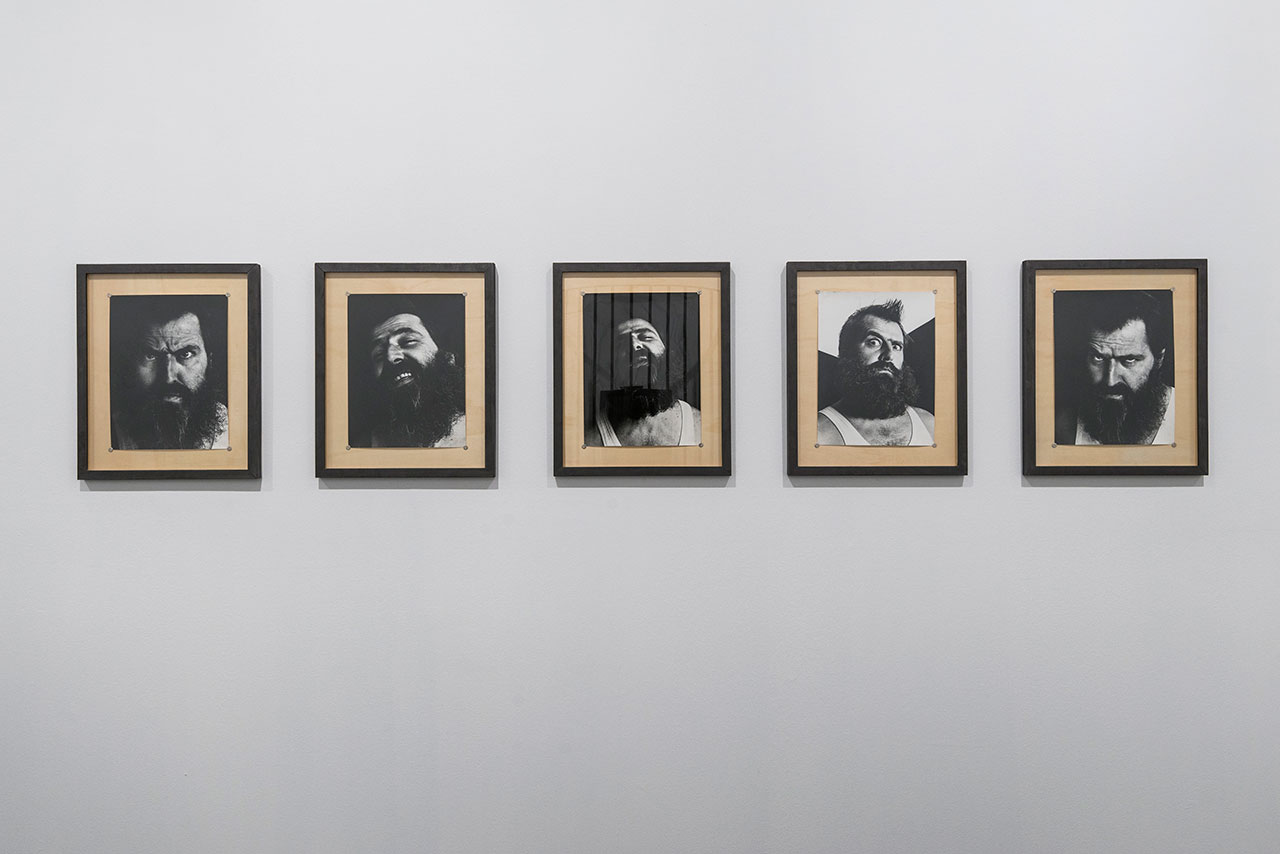
Michelangelo Pistoletto “One and One makes Three” at Basilica di San Giorgio, Isola di San Giorgio Maggiore, Venice Biennale, 2017. Courtesy the artist and GALLERIA CONTINUA, San Gimignano / Beijing / Les Moulins / Habana. Photo by Oak Taylor-Smith.
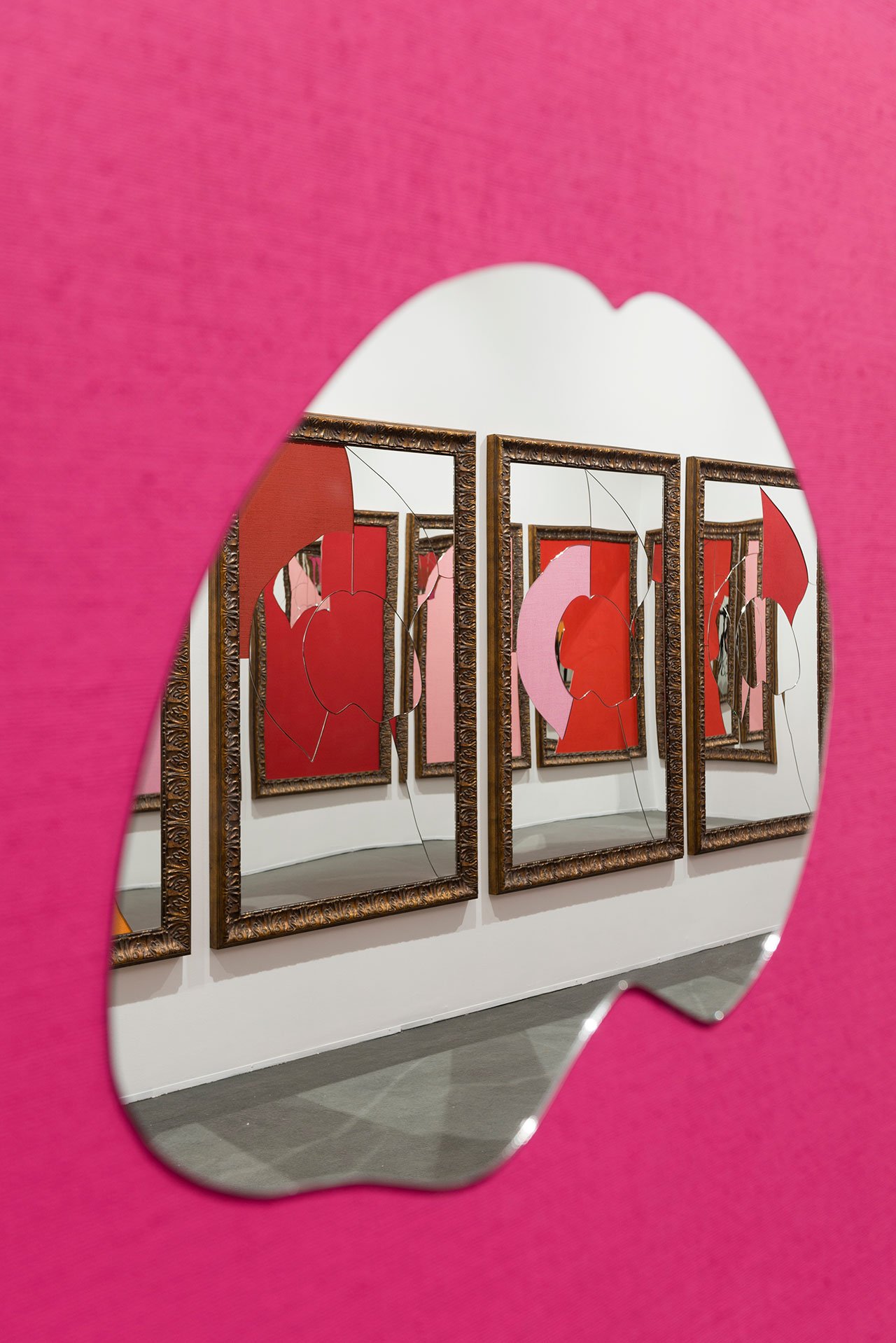
Michelangelo Pistoletto “One and One makes Three” at Basilica di San Giorgio, Isola di San Giorgio Maggiore, Venice Biennale, 2017. Courtesy the artist and GALLERIA CONTINUA, San Gimignano / Beijing / Les Moulins / Habana. Photo by Oak Taylor-Smith.
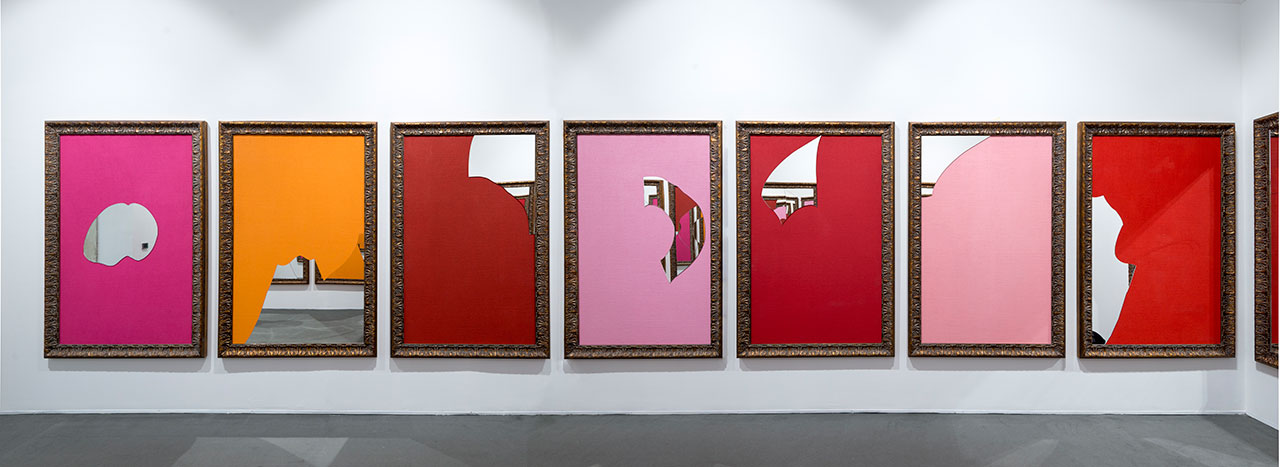
Michelangelo Pistoletto “One and One makes Three” at Basilica di San Giorgio, Isola di San Giorgio Maggiore, Venice Biennale, 2017. Courtesy the artist and GALLERIA CONTINUA, San Gimignano / Beijing / Les Moulins / Habana. Photo by Oak Taylor-Smith.
Another large mirror installation, “The Time of Judgement” (2009-2017), can be found in the chapter room. Depicting Judaism, Catholicism, Islam and Buddhism, each one represented by a symbolic element placed in front of a mirror—a statue of Buddha, a prayer mat facing Mecca, a kneeler and a pair of arched mirrors that stand in for the Jewish Torah—the installation is yet another example of the socially-engaged art that the artist has championed. Configured like a temple, where each ‘altar’ is always seen among the reflections of the others, it attempts to establish a balance between the political and religious conflicts that have wreaked so much havoc on the world.
The exhibition concludes with his most recent work, “Colour and Light” (2016), a series of framed canvases painted monochromatically in bright colors upon which broken pieces of mirror have been affixed. Since mirrors, for Pistoletto, represent an image of the world, by breaking them he is dividing the image of the cosmos into many fragments, one for every single person. Hung side by side on opposite walls, viewers can’t help piecing them together in their mind, an act of re-composition that alludes to the formation of society and perfectly illustrates the artist’s belief that ultimately "the material for making art is not just canvas, wood or marble – but society itself."
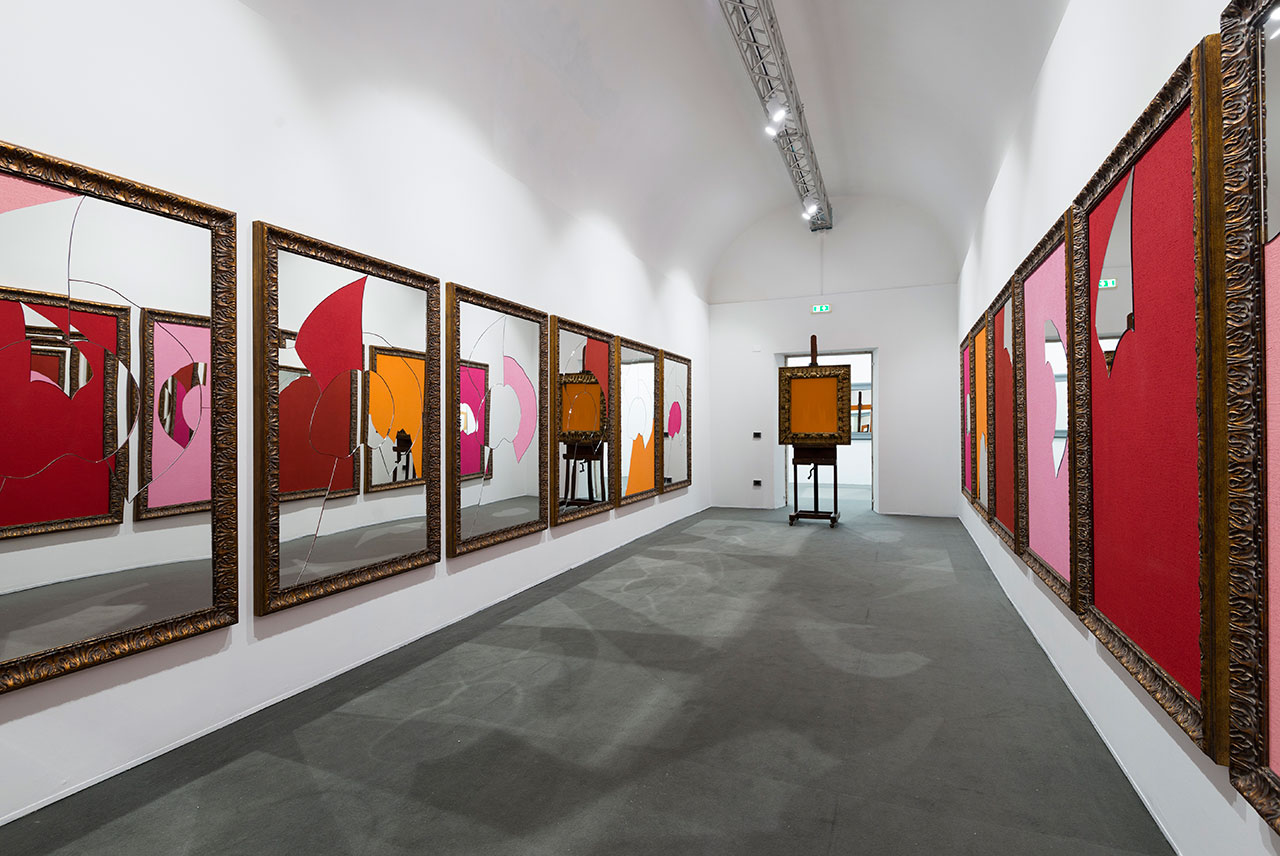
Michelangelo Pistoletto “One and One makes Three” at Basilica di San Giorgio, Isola di San Giorgio Maggiore, Venice Biennale, 2017. Courtesy the artist and GALLERIA CONTINUA, San Gimignano / Beijing / Les Moulins / Habana. Photo by Oak Taylor-Smith.
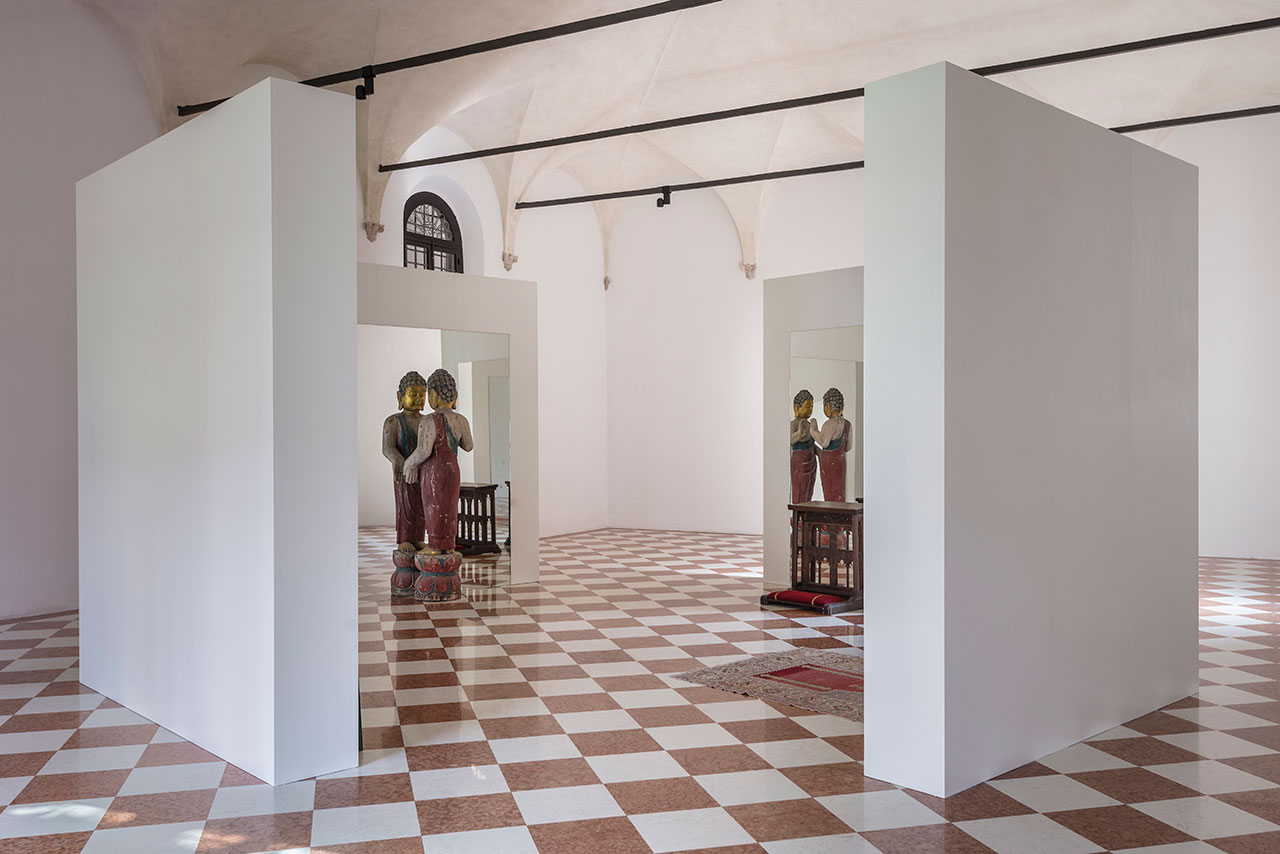
Michelangelo Pistoletto “One and One makes Three” at Basilica di San Giorgio, Isola di San Giorgio Maggiore, Venice Biennale, 2017. Courtesy the artist and GALLERIA CONTINUA, San Gimignano / Beijing / Les Moulins / Habana. Photo by Oak Taylor-Smith.
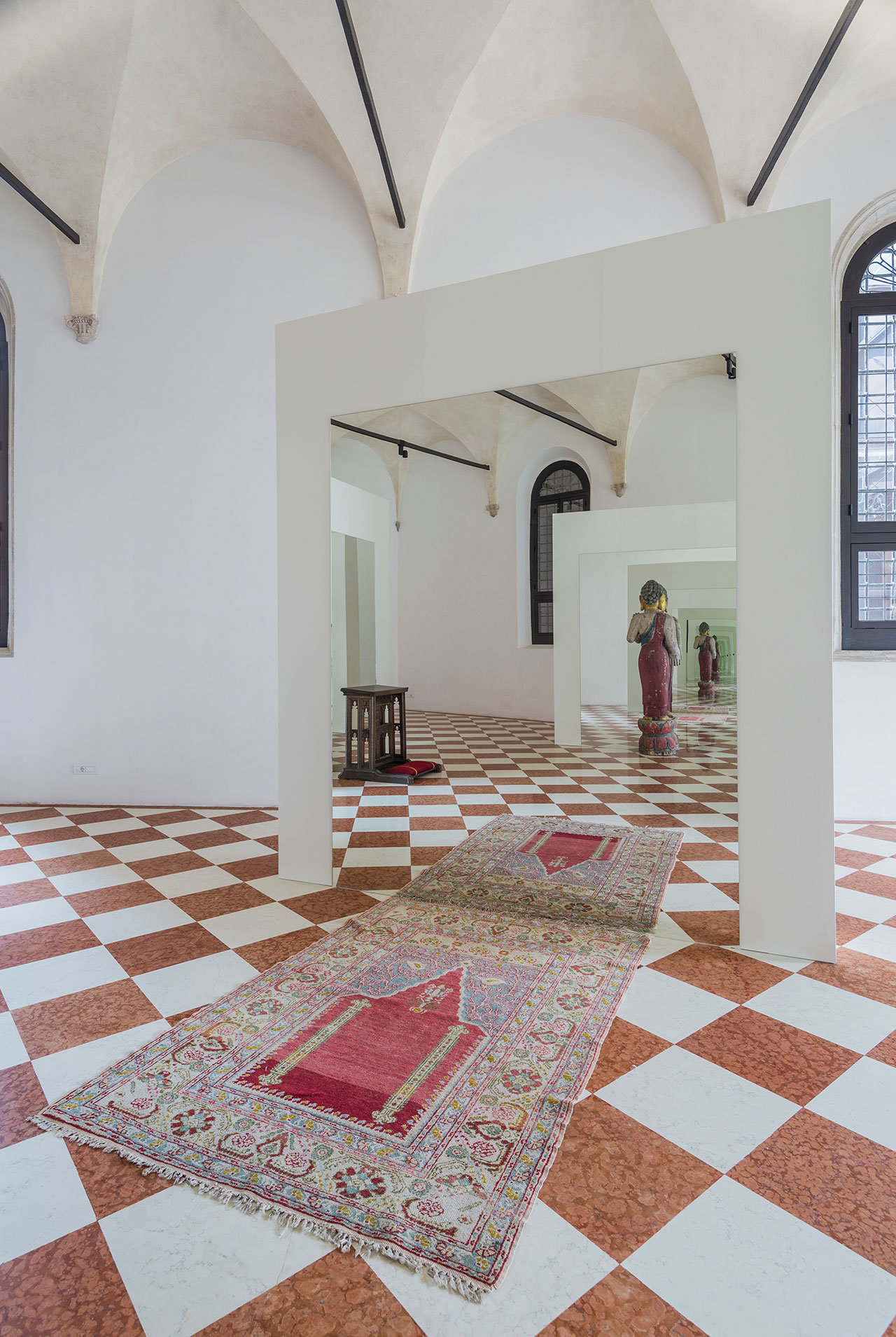
Michelangelo Pistoletto “One and One makes Three” at Basilica di San Giorgio, Isola di San Giorgio Maggiore, Venice Biennale, 2017. Courtesy the artist and GALLERIA CONTINUA, San Gimignano / Beijing / Les Moulins / Habana. Photo by Oak Taylor-Smith.
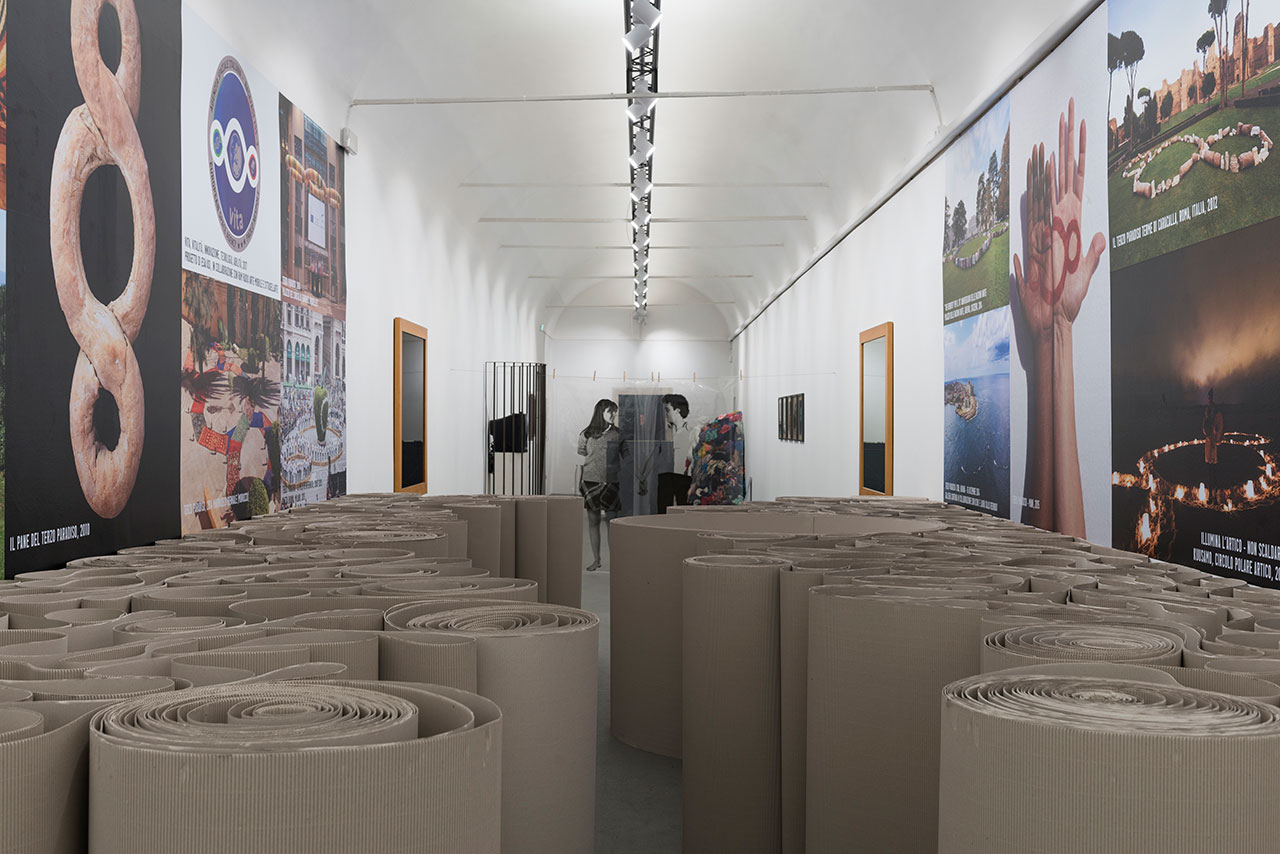
Michelangelo Pistoletto “One and One makes Three” at Basilica di San Giorgio, Isola di San Giorgio Maggiore, Venice Biennale, 2017. Courtesy the artist and GALLERIA CONTINUA, San Gimignano / Beijing / Les Moulins / Habana. Photo by Oak Taylor-Smith.
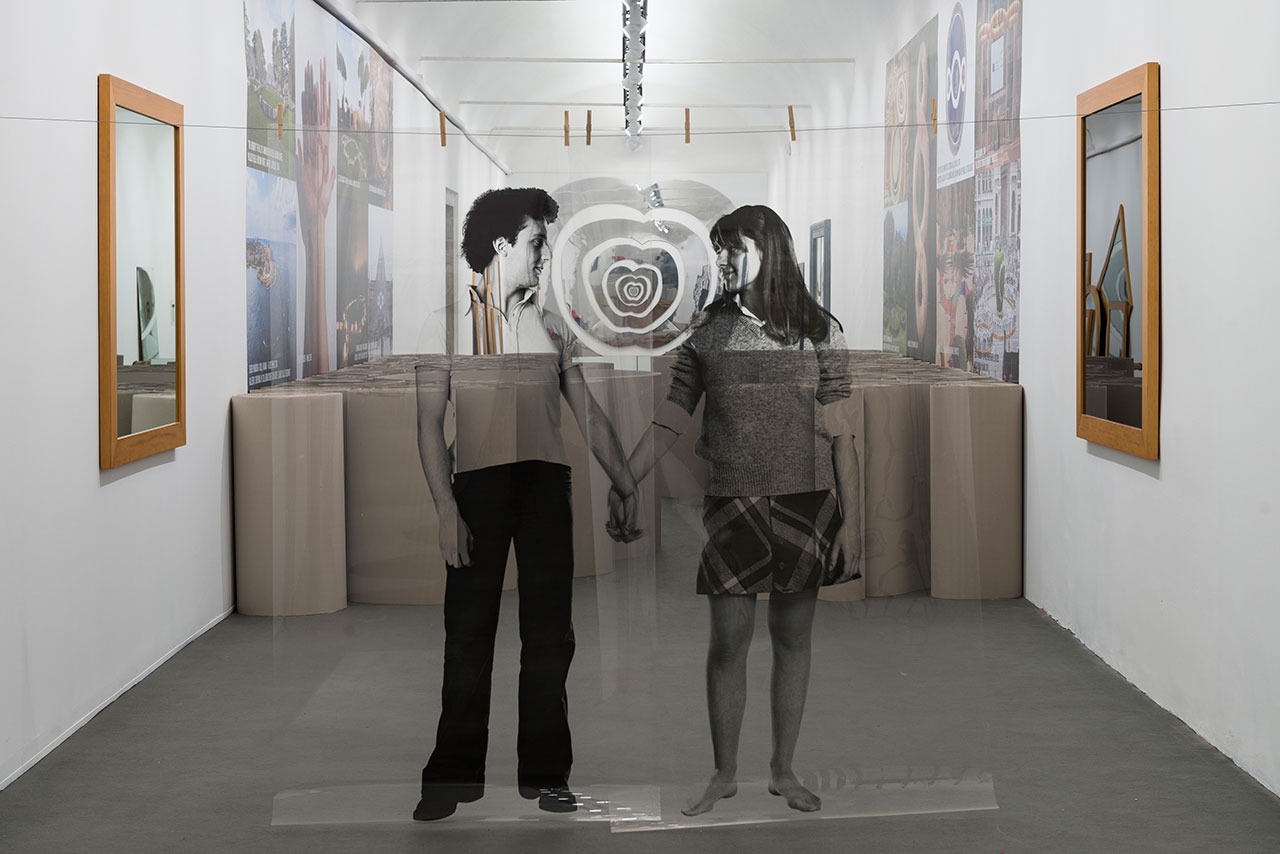
Michelangelo Pistoletto “One and One makes Three” at Basilica di San Giorgio, Isola di San Giorgio Maggiore, Venice Biennale, 2017. Courtesy the artist and GALLERIA CONTINUA, San Gimignano / Beijing / Les Moulins / Habana. Photo by Oak Taylor-Smith.
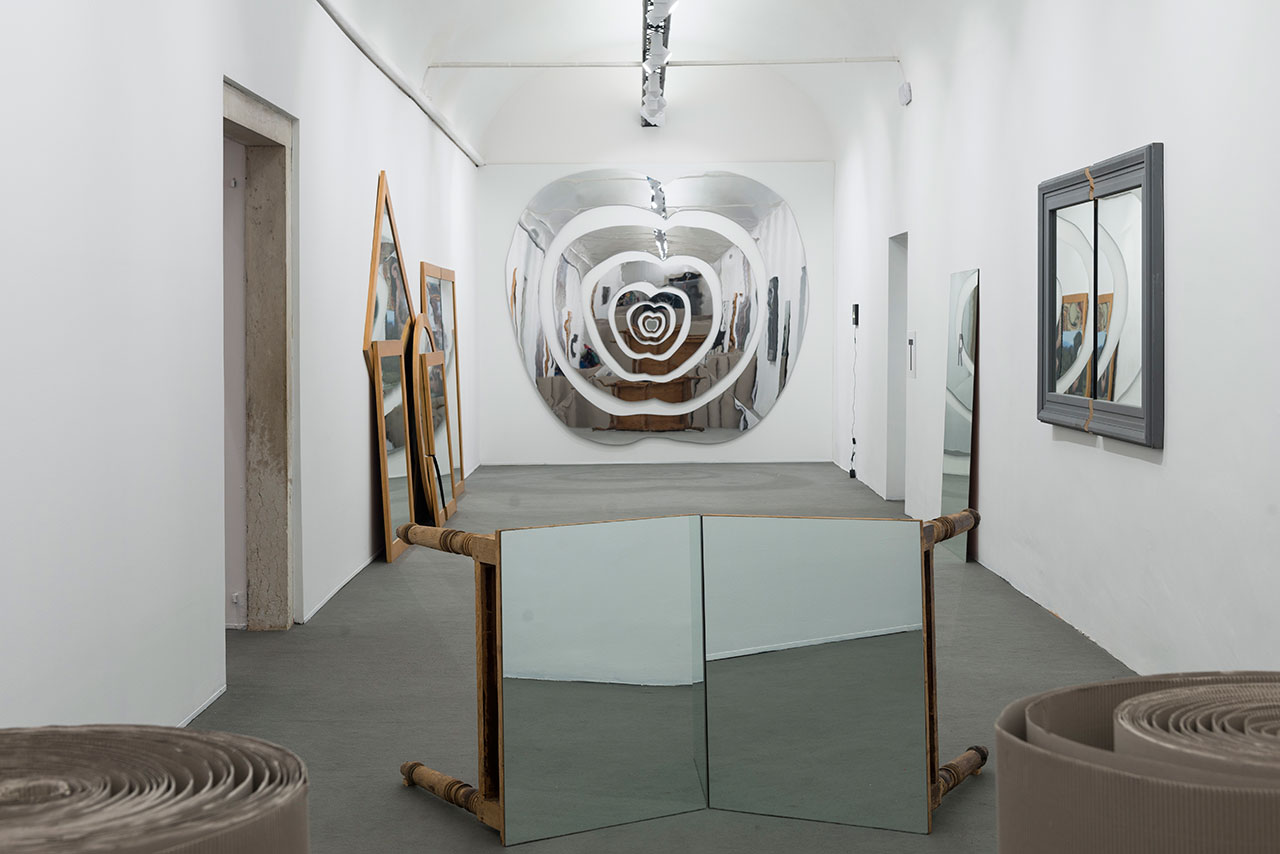
Michelangelo Pistoletto “One and One makes Three” at Basilica di San Giorgio, Isola di San Giorgio Maggiore, Venice Biennale, 2017. Courtesy the artist and GALLERIA CONTINUA, San Gimignano / Beijing / Les Moulins / Habana. Photo by Oak Taylor-Smith.
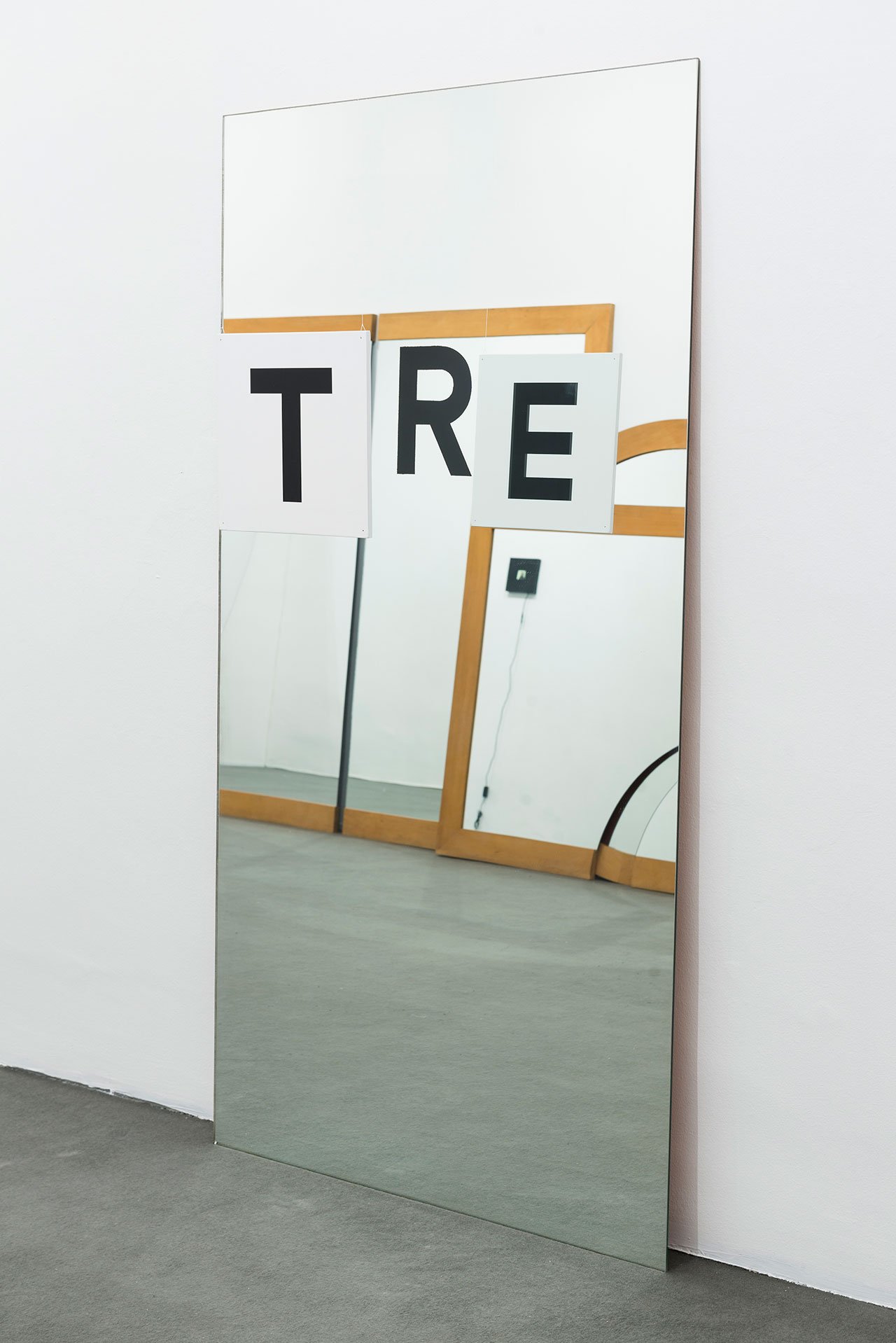
Michelangelo Pistoletto “One and One makes Three” at Basilica di San Giorgio, Isola di San Giorgio Maggiore, Venice Biennale, 2017. Courtesy the artist and GALLERIA CONTINUA, San Gimignano / Beijing / Les Moulins / Habana. Photo by Oak Taylor-Smith.















